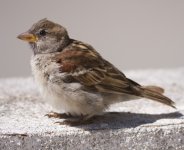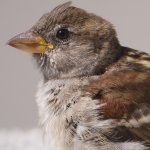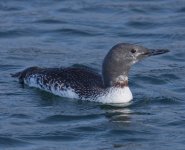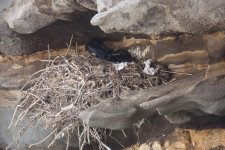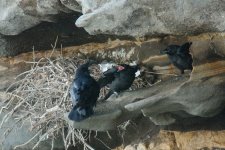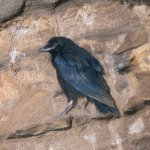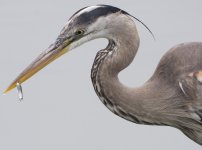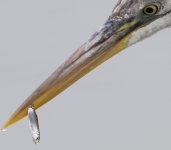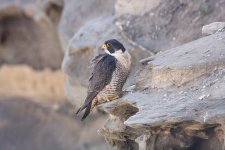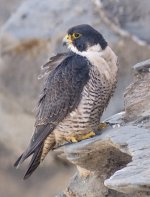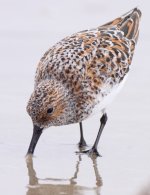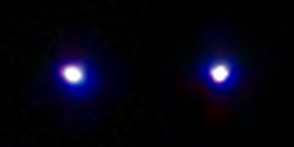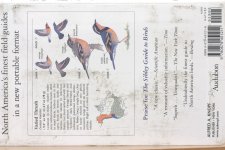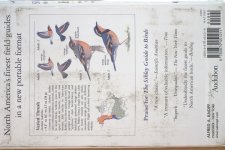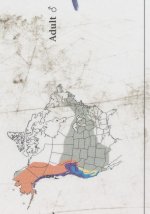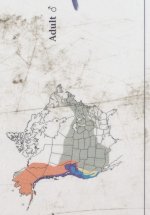David Ellsworth
Well-known member
I've had a Canon 100-400mm f/4.5-5.6 for almost 2 years now. I love this lens; it's corner-to-corner sharp when correctly collimated, and the zoom, USM, IS, and ability to take teleconverters make it quite versatile. When stopped down to f/6.3 at full tele, it can take stacked 2x and 1.4x teleconverters and still be sharp. (Note that my copy of this lens is actually 103.7-389mm, not 100-400mm.)
But I wanted more aperture. With teleconverters on, the 100-400mm becomes too slow to get low ISOs and fast shutter speeds on moving subjects; also it doesn't quite have enough diffraction-limited resolving power to take full advantage of good seeing (low atmospheric thermal distortion) when photographing distant subjects such as nests and aeries.
The supertelephoto lenses are far too expensive. The only remaining choice was a telescope. I eliminated reflectors as a choice long ago, because although cheaper for the same aperture, they give donut-shaped bokeh and are either too slow (e.g. f/10 catadioptrics) or are hard to use for daytime eyepiece viewing and straight-through sighting. That left apochromatic refractors as the only choice.
Finally I took the plunge and decided on the Explore Scientific 127mm f/7.5 triplet. It's very heavy, but has comparable aperture to a Canon 600mm f/4 for high-power use (the 600mm is actually just 585mm, and needs to be stopped down to f/4.5 or f/5 for good sharpness especially with stacked teleconverters); I was sick of 500 and 600mm f/4 envy, so I wanted a telescope that could match one at least in useful aperture and resolving power, if not autofocus, image stabilization and ease of portability.
The ES127 is 952.5mm f/7.5 and weighs 17.8 pounds without a camera or eyepiece attached (but with dew shield / hood). It's an effort to carry it around, but it can be done and I have been doing it.
Sharpness is excellent. There's a touch of violet-fringe CA that can only be seen against very sharp contrasts (and becomes more apparent with teleconverters attached). At 952mm it can often crop all but the smallest birds, so I bought the Televue 0.8x Reducer/Flattener for 800-1000mm telescopes (RFL-4087). This works quite well, and turns the scope into a 756mm f/6. I have often put a 2x teleconverter on my 100-400mm for tripod use, which makes that lens effectively 775mm — so this is a focal length that's already familiar to me (albeit with the ability to zoom out to 207mm, which I don't have on the telescope).
The ED127's dual-speed (7.7:1) Crayford focuser is a joy to use. It's the best manual focusing experience I've ever had. However one big problem I've been having with the ED127 is getting extension tubes and other 2" components to tighten parallel to the focal plane; the ED127's focuser has its brass ring in a nonstandard position. I've given my thumb a callus from repeated tightening of thumbscrews! I've managed to reduce the problem quite a bit by using a 2" Parfocalizing Ring.
Despite being designed for astronomy, the ES127 performs great at close focusing! I tried stacking extension tubes to test out its capabilities. I haven't yet taken this scope far from home, and I've only had it for 2 weeks so far; I've been using much of that time to test the technical capabilities of the scope and figuring out how best to use it. So I don't yet have a lot of shots that I feel are perfect for showing off the scope. However, here is a photograph of a juvenile House Sparrow on my balcony, at about 5.4 meters distance; I used the RFL-4087 and Canon 40D for this shot.
To show both overall image quality and fine pixel detail, I'm posting three different crops. The first one is only cropped horizontally, not vertically. The second is a 66.7% crop, and the third is a 100% crop.
Has anyone else used a 120+ mm refractor for bird photography?
I'm interested in replacing the dew shield with a lightweight hood, perhaps Kydex as one person recommended in a review of the ED127, but I'm not sure how to go about this and would appreciate advice. I would also appreciate advice on how best to build or procure an aperture limiter, for stopping down a refractor (to get more depth of field and less chromatic aberration).
I can't help but think that the f/5.95 with ES127 + RFL-4087 is probably enough for a xxD / xxxD body to give reliable focus confirmation. Unfortunately it would be necessary either to hack together some electronics to trick the camera into doing this, or to hack the firmware to accomplish the same thing.
The lack of electronics in the EOS bayonet adapter results in some odd behavior by my 450D and 40D. Both cameras show incorrect Live View exposure preview. The 40D's problem is much worse. The 450D can be cured by attaching it to a real EF or EF-S lens after being turned on (and turning off auto power down so this doesn't have to be done repeatedly) before moving it onto the telescope. However this doesn't fix the problem on the 40D, and the 40D's exposure preview offset is not even constant. The other problem is that trying to shoot a picture with an EF teleconverter attached to the scope results in an error message, unless I tape the contacts on the closest teleconverter. Has anyone else had these problems?
But I wanted more aperture. With teleconverters on, the 100-400mm becomes too slow to get low ISOs and fast shutter speeds on moving subjects; also it doesn't quite have enough diffraction-limited resolving power to take full advantage of good seeing (low atmospheric thermal distortion) when photographing distant subjects such as nests and aeries.
The supertelephoto lenses are far too expensive. The only remaining choice was a telescope. I eliminated reflectors as a choice long ago, because although cheaper for the same aperture, they give donut-shaped bokeh and are either too slow (e.g. f/10 catadioptrics) or are hard to use for daytime eyepiece viewing and straight-through sighting. That left apochromatic refractors as the only choice.
Finally I took the plunge and decided on the Explore Scientific 127mm f/7.5 triplet. It's very heavy, but has comparable aperture to a Canon 600mm f/4 for high-power use (the 600mm is actually just 585mm, and needs to be stopped down to f/4.5 or f/5 for good sharpness especially with stacked teleconverters); I was sick of 500 and 600mm f/4 envy, so I wanted a telescope that could match one at least in useful aperture and resolving power, if not autofocus, image stabilization and ease of portability.
The ES127 is 952.5mm f/7.5 and weighs 17.8 pounds without a camera or eyepiece attached (but with dew shield / hood). It's an effort to carry it around, but it can be done and I have been doing it.
Sharpness is excellent. There's a touch of violet-fringe CA that can only be seen against very sharp contrasts (and becomes more apparent with teleconverters attached). At 952mm it can often crop all but the smallest birds, so I bought the Televue 0.8x Reducer/Flattener for 800-1000mm telescopes (RFL-4087). This works quite well, and turns the scope into a 756mm f/6. I have often put a 2x teleconverter on my 100-400mm for tripod use, which makes that lens effectively 775mm — so this is a focal length that's already familiar to me (albeit with the ability to zoom out to 207mm, which I don't have on the telescope).
The ED127's dual-speed (7.7:1) Crayford focuser is a joy to use. It's the best manual focusing experience I've ever had. However one big problem I've been having with the ED127 is getting extension tubes and other 2" components to tighten parallel to the focal plane; the ED127's focuser has its brass ring in a nonstandard position. I've given my thumb a callus from repeated tightening of thumbscrews! I've managed to reduce the problem quite a bit by using a 2" Parfocalizing Ring.
Despite being designed for astronomy, the ES127 performs great at close focusing! I tried stacking extension tubes to test out its capabilities. I haven't yet taken this scope far from home, and I've only had it for 2 weeks so far; I've been using much of that time to test the technical capabilities of the scope and figuring out how best to use it. So I don't yet have a lot of shots that I feel are perfect for showing off the scope. However, here is a photograph of a juvenile House Sparrow on my balcony, at about 5.4 meters distance; I used the RFL-4087 and Canon 40D for this shot.
To show both overall image quality and fine pixel detail, I'm posting three different crops. The first one is only cropped horizontally, not vertically. The second is a 66.7% crop, and the third is a 100% crop.
Has anyone else used a 120+ mm refractor for bird photography?
I'm interested in replacing the dew shield with a lightweight hood, perhaps Kydex as one person recommended in a review of the ED127, but I'm not sure how to go about this and would appreciate advice. I would also appreciate advice on how best to build or procure an aperture limiter, for stopping down a refractor (to get more depth of field and less chromatic aberration).
I can't help but think that the f/5.95 with ES127 + RFL-4087 is probably enough for a xxD / xxxD body to give reliable focus confirmation. Unfortunately it would be necessary either to hack together some electronics to trick the camera into doing this, or to hack the firmware to accomplish the same thing.
The lack of electronics in the EOS bayonet adapter results in some odd behavior by my 450D and 40D. Both cameras show incorrect Live View exposure preview. The 40D's problem is much worse. The 450D can be cured by attaching it to a real EF or EF-S lens after being turned on (and turning off auto power down so this doesn't have to be done repeatedly) before moving it onto the telescope. However this doesn't fix the problem on the 40D, and the 40D's exposure preview offset is not even constant. The other problem is that trying to shoot a picture with an EF teleconverter attached to the scope results in an error message, unless I tape the contacts on the closest teleconverter. Has anyone else had these problems?
Attachments
Last edited:




